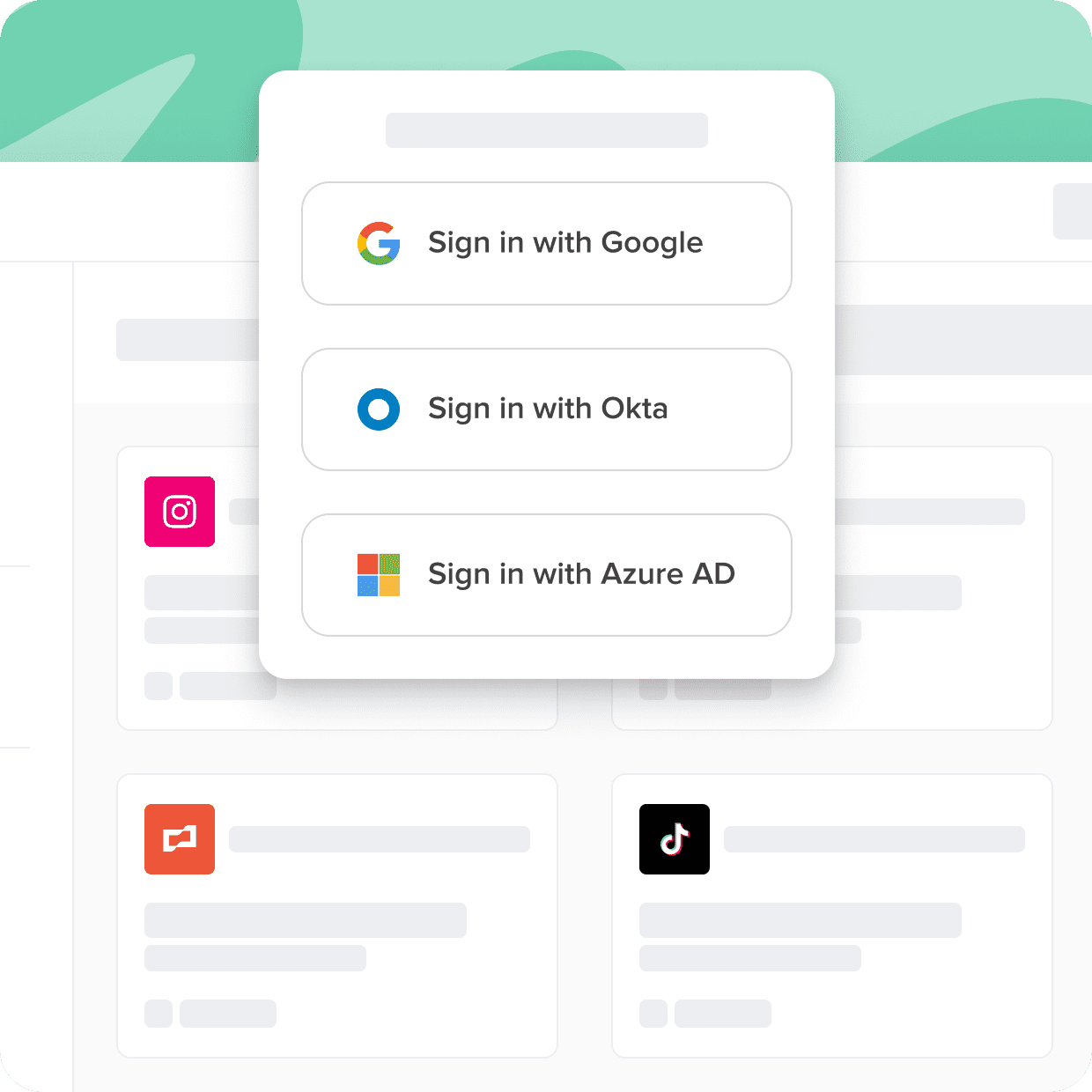Zero trust identity and access management (IAM) is a security paradigm that requires all access attempts, even those coming from within a network, to be verified and authenticated continuously. With the integration of SSO, you can enhance your security and control over user access to various applications and resources. Unfortunately, many corporate applications don't support the SSO standard and can't reap all the benefits. The applications that fall into this category are best called "nonfederated." Nonfederated applications are a new category that is becoming increasingly challenging for businesses to manage and secure effectively, yet increasingly critical for businesses to succeed.
Cerby connects all of your apps to your SSO tools, even if they don't support the SSO standard. In this guide, you'll learn about different SSO tools, the challenges, and the players.
Streamline Access With Single Sign-On
Not all apps are created equal. Some come with security gaps and complexities that can hinder user adoption and put sensitive data at risk. With Cerby, you can ensure secure and seamless access to all your applications, regardless of their support for standards like SSO.
With Cerby You Can

Close the identity gap

Universally enforce 2FA

Eliminate the SSO tax
Zero Trust Identity And Access Management
In today's fast-paced business environment, security is a top concern for organizations, particularly when it comes to identity and access management (IAM). The traditional IAM approach relied on the perimeter security model, where access to resources within the corporate network was limited through firewalls, VPNs, and other security mechanisms. However, with the rise of cloud computing and the proliferation of remote work, the perimeter model has proven less effective, leading to a shift towards a zero-trust security model.
Zero trust identity and access management is a security paradigm that requires all access attempts, even those coming from within a network, to be verified and authenticated continuously. At its core, zero trust aims to protect organizational resources by treating every user, device, and access attempt as inherently untrustworthy. This requires organizations to verify the identity and context of all users and devices, monitor user behavior in real time, and only grant access to those who are authorized based on the organization's policies.
In the Ponemon Institute study, “Security and identity teams are often left out of managing and manually controlling access to nonfederated applications. According to the research, shared management of nonfederated applications leads to a decentralized approach. Business units (63 percent of respondents) are most likely to manage these applications, followed by IT teams (54 percent of respondents). Only 45 percent of respondents say the security and/or identity teams are responsible for managing these applications. Moreover, 54 percent of respondents say business units control the granting and revoking of access.”
Traditional IAM security operates on the assumption that certain users and devices are trustworthy and do not pose a risk to the organization. The system grants access to resources based on predetermined roles and permissions, and security measures are implemented to protect the perimeter. However, with the growing sophistication of cyber attacks and the rise of insider threats, relying on this assumption is no longer a viable security strategy. The zero trust security approach differs in that it continuously assesses the trustworthiness of users, devices, and access requests to determine whether to grant access to resources.
Zero trust security involves establishing multiple layers of trust verification through methods like multi-factor authentication, identity and access management (IAM) policies, granular access controls, and behavior-based analytics. This approach ensures that access is granted only to those who truly need it and is restricted when necessary to reduce the attack surface and mitigate risks. Compared to traditional IAM approaches, zero trust security provides a comprehensive and proactive approach to protecting organizational resources.
Zero Trust Architecture
Zero trust architecture is a security model based on the principle that organizations should not automatically trust any user and should always verify the identity of users, devices, and processes before allowing access to resources. This principle forms the core of zero-trust security principles, which enable organizations to enhance their cybersecurity postures by adopting frameworks that leverage identification, authentication, and authorization to provide granular access controls.
For example, the NIST zero trust framework provides guidelines for implementing zero trust by providing a comprehensive reference architecture that organizations can use to design and implement zero trust security solutions. This framework centers on the concept of least privilege, which is the principle of providing users with the lowest level of access required to perform their jobs. An effective zero-trust framework typically includes several principles, including continuous authentication (where access is continually monitored, evaluated, and authorized based on the user's identity, behavior, and context) and micro-segmentation (which involves partitioning networks and resources into small segments that are isolated from each other).
By adopting an effective zero-trust framework, organizations can significantly enhance their cybersecurity postures by addressing the asymmetric threats emerging through the proliferation of remote work, cloud-based applications, and interconnected networks. A zero-trust framework provides a holistic approach to security that reduces the attack surface, limits the impact of breaches, and enables rapid detection and mitigation of security risks.
How To Implement Zero Trust
Organizations need to leverage zero trust authentication, identity, and access management tools that provide continuous monitoring and authorization to implement zero trust security. Zero trust authentication solutions include multi-factor authentication (MFA), which adds an extra layer of security beyond the traditional username and password. Other tools like privileged access management (PAM) solutions provide granular access controls, vault privileged credentials, and monitor privileged sessions in real time. Zero trust identity solutions include identity governance and administration (IGA) tools that provide a centralized view of the user's identity, roles, and entitlements. Additionally, identity federation solutions provide seamless access across multiple applications and services while enforcing identity and access policies.
To implement zero trust best practices, organizations must follow a zero trust implementation roadmap, which includes steps like:
- Identifying data, assets, and applications
- Developing a comprehensive risk management strategy and access policies
- Designing protections that include intrusion prevention and detection, network segmentation, and endpoint security measures.
Microsoft includes Azure Active Directory (AAD) and Microsoft Defender solutions with its zero trust architecture. Microsoft's AAD provides centralized authentication and access controls, while Microsoft Defender provides endpoint detection and response solutions.
Implementing zero trust in identity and access management requires adopting zero trust principles, leveraging zero trust authentication, identity, and access management tools, and following zero trust implementation best practices. The adoption of zero trust in identity and access management has become essential in cloud computing environments to ensure that IAM policies are enforced continuously and unauthorized events are detected rapidly. Tools and vendors like Microsoft and Cerby can help blaze a trail for a more secure, zero-trust future.
Zero Trust Identity Provider
Major technology companies such as Microsoft, AWS, and Okta are leading the charge in offering zero-trust solutions to help organizations enhance their security.
First of all, identity and access management AWS solutions enable customers to enforce granular access controls, enforce multi-factor authentication, and identify and manage access risks continuously.
Additionally, Microsoft's zero trust approach focuses on comprehensive identity and access management solutions that provide secure access to all devices, applications, and data regardless of location. Microsoft Zero trust solutions include Azure Active Directory, Microsoft's cloud-based directory service, which provides single sign-on, multi-factor authentication, and conditional access policies. Microsoft's Endpoint Manager provides device management and security, and Microsoft Defender provides endpoint detection and response solutions.
Finally, Okta offers a zero-trust identity provider platform that enables secure access to all cloud applications, data, and services, regardless of location or device. The Okta platform offers a range of authentication methods and supports SAML, OAuth, and OpenID Connect, providing secure access to cloud and on-premise applications. Okta also offers platform services that integrate with other zero-trust solutions like endpoint protection and cloud access security brokers.
By treating every user, device, and access attempt as untrusted, these major technology companies create an environment of continuous monitoring and risk-based decision-making that can detect and remediate unauthorized access and potential security threats quickly.
The zero trust offerings from major technology companies like Microsoft, AWS, and Okta provide organizations with comprehensive identity and access management solutions that enable secure access to all cloud and on-premise applications, data, and services. These solutions help enhance security by enforcing granular access controls, enforcing multi-factor authentication, and continuously identifying and managing access risks. By treating every user, device, and access attempt as potentially hostile, these solutions offer robust frameworks for securing networks and protecting sensitive data.
Identity And Access Management Tools
As the security landscape continues to evolve, identity and access management tools have become an essential component of organizational cybersecurity strategies. One concept that has gained substantial traction in recent years is zero trust. Zero trust architecture examples include the principle of assuming that all users are potentially hostile, with access decisions made by continuously verifying identity and context regardless of the location or device used to access network resources.
While zero trust takes a fundamentally different approach than traditional IAM solutions, it is not a complete replacement, nor even necessarily a matter of zero trust vs. IAM. Zero trust offers additional layers of authentication and access controls, while IAM focuses on managing user credentials, permissions, and roles. However, IAM solutions often fall short when users access resources outside of the corporate network, making zero trust an increasingly attractive option in the age of remote work.
The market's response to this growing demand has seen a significant increase in zero trust vendors offering privileged access management, cloud security, and micro-segmentation features, further cementing zero trust's place as a key player in the future of cybersecurity. These vendors enable organizations to continuously monitor user activity, detect potential threats, and respond accordingly, thereby limiting the risk of cyberattacks.
Emerging technologies such as AI, machine learning, and blockchain also have the potential to transform the way zero trust identity and access management operates. AI algorithms can identify patterns and anomalies in the network activity, flagging suspicious behavior that may evade traditional security measures. Machine learning can improve identity verification and streamline access management processes, while blockchain can provide immutability and transparency to identity management transactions.
Zero trust identity and access management are poised to become the new standard in cybersecurity. The combination of emerging technologies, evolving cyber threats, and the ever-growing demand for data security will continue to drive the adoption of zero-trust solutions. While IAM will remain a critical component of cybersecurity strategy, zero trust's innovative approach provides a more comprehensive framework for securing network resources, and its growing popularity suggests that it is here to stay.

